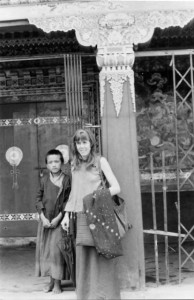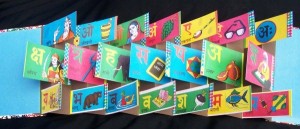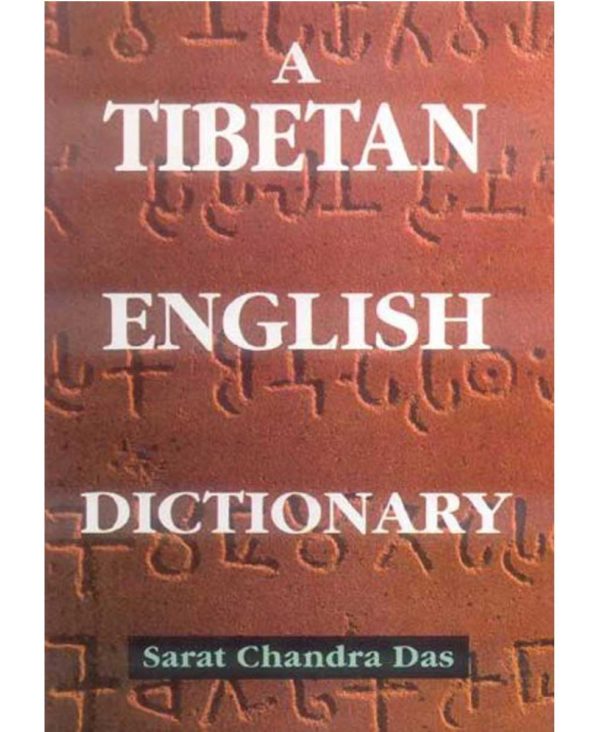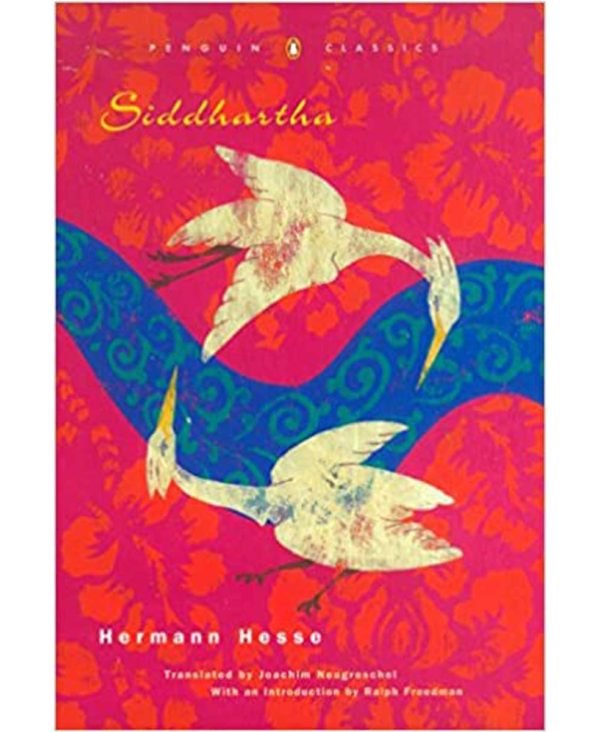
24 Feb Sleeping in Caves, a Conversation with Marilyn Stablein
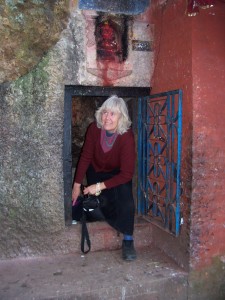
Award-winning poet, essayist and book artist, Marilyn Stablein, exiting a popular cave shrine in Kathmandu
We recently had the pleasure of talking with award-winning poet, essayist and artist, Marilyn Stablein about her colorful and rich experiences traveling in India, as a teenager in the 1960s.
Levitating Monkey: In your memoir, Sleeping in Caves: A Sixties Himalayan Memoir, you detail how you dropped out of Berkeley and travelled to India and Nepal with your lover in the 60s. “There are times when I ask myself,” Stablein writes, “What am I am doing here? My answer: to paint, to study a culture; to uncover its secrets; to listen to the whisperings, the sacred oral traditions; to learn by heart the names and faces of deities so I can capture their images on paper and strive to imbue each image with the greatness of its namesake, its spiritual essence. Art is my muse and practice. The world is my palette, artists my teachers; art lives and breathes in the people I meet.” Can you share with us how your brief getaway turned into a seven-year stay?
Marilyn Stablein: As a teenager I was entranced by Satyajit Ray’s films, a Ravi Shankar concert and the novel Siddhartha by Herman Hesse. After my freshman year at UC Berkeley during the tumultuous Free Speech Movement I left home to travel abroad for the summer. Since student travels in the 60s was inexpensive I kept extending my return home. From the moment I set foot in India a year later I felt an immediate attraction to Indian culture and historical Buddhist sacred sites. Within a month I visited the caves at Ajanta, Ellora, Karla, Elephanta and Kanheri.
My partner and I rented a room at the Burmese pilgrim hostel in Sarnath and settled down to pursue in the peace and solitude of that quiet village our studies of Hindu and Tibetan culture. I learned both Hindi and Tibetan scripts (devanagari and uchen) and slowly I taught myself the Tibetan language, looking up word after word in the big Chandra Das dictionary. When I left my room in Sarnath I crossed a courtyard and passed through the western gate to the Deer Park where the Buddha delivered one of his most important sermons:”The Turning of the Wheel of the Law” or “Dharmachakra” sermon over 2,500 years earlier. Ancient Hindu and Buddhist pilgrimage sites are vibrant power places that energize and inspire me.
Perhaps growing up in California on the Pacific Rim with the cross-fertilization of oriental cultures, especially Chinese and Japanese, explains why I felt so comfortable as a teenager settling down in a hermitage to study mandala painting and calligraphy. Season after season passed. Soon a year elapsed followed by another year and another. A few chapter titles from my memoir Sleeping in Caves captures some of the details:”Rituals of Curry,” “Cave Monasteries,” “Yab Yum Nights,” “Sacred Waters,” “the Bardo of Listening Souls.”
LM: In 1965, you started roaming the subcontinent of India as a spiritual tourist that moved with the seasons, making pilgrimages to holy caves, rivers and meeting the Dalai Lama. Looking back now, what do you feel were the top three most significant events that occurred while you were on this trip?
MS: There were so many incredible experiences. Every meeting with a spiritual teacher, sadhu, yogi, guru or saint whether at the burning ghat in Benares, on the Amarnath Yatra trail at 13,000ft. in Kashmir or at a lonely, desolate monastery was definitely a significant event. To name a few remarkable people: Sri Anandamayi Ma, Ganesh Baba, Neem Kaurali Baba, H.H. Dudjom Rinpoche and His Holiness the Dalai Lama.
I met my first husband, a Fulbright scholar studying Mahakala at the Sanskrit University in Benares. We had two weddings in Nepal a year later. The first was an ancient fire ceremony or puja in the Queen’s Forest. The second was atop the Tibetan monastery in Svayambunath witnessed by an embassy official.
The birth of my first child, a son, in Kathmandu was definitely a life-changing momentous and joyous experience.
LM: On the lighter side, you talk about chai (Asian spiced tea), dung beetles, leeches and an ice lingam in your book. What was your first reaction to India when you first set foot off the plane?
MS: As a student I didn’t have a tourist’s travel budget. My partner and I hitchhiked overland to India passing through Turkey and Iran. My first impression when I got off the boat in Mumbhai from Karachi, (the Northern border with Pakistan was closed), were the overwhelmingly colorful, chaotic, and fascinating street scenes. Muscular men pedaled bicycle rickshaws, bells clanged, temple bells echoed, beggars and vendors both vied for our attention. Signs were in Hindi & rarely English. A sacred cow sat in a busy street halting taxis, buses and a bullock cart. Wafting aromas of a street food cart tempted us with spicy samosas and pakoras, women glided almost above ground in colorful, diaphanous silk saris. Over a cup of the ubiquitous, aromatic and delicious chai we planned our next step which was to get a rickshaw ride to the Sikh Gurudwara hostel for pilgrims.
We soon abandoned the bustling street life in favor of the quietude of villages, the serenity of rivers and spiritual centers. I began to teach myself calligraphy and mandala painting by copying from old scroll paintings.
LM: Not giving anything away to our readers, at the time when you were deported from India and moved to Nepal, did you have any intention of moving back to the states?
MS: Of course after four years without seeing or talking with family or friends back home I was homesick. Before cell phones, the internet, and Skype the only communication was through letters that took at least a week, sometimes two, in transit. Also since my address changed constantly I had to plan in advance where to collect mail, usually c/o Post Restante in various rural post offices. I missed my sister’s wedding, a brother’s graduation, my father’s retirement, my grandfather’s funeral and scores of family gatherings. I’d heard about Kent State, the women’s liberation movement, political protests, anti-Vietnam war demonstrations and the summer of love from travelers passing through and by reading an occasional English language newspaper. Friends played scratchy tapes of Janis Joplin, Jimi Hendrix and the Woodstock Festival. There were so many temptations and yearnings. I definitely wanted to return home and see loved ones and catch up. I planned to sort things out in Nepal but unexpected life changing events interceded.
LM: In your memoir, you talk about meditation in caves…can you share with our readers how you first got involved in meditation, what you learned via the caves experience?
MS: Meditation helps focus the mind. Absorbing the reality of the moment and a heightened awareness expands consciousness. There are very specific meditation exercises that require elaborate visualizations dedicated to a deity or Buddha or to a philosophical concept like sunyata, nothingness. Devotional recitations or bhajan focuses on breath and sound to heighten one’s consciousness.
Over a five year period I received many teachings, initiations and empowerments. The important thing is that meditation in whatever form or context is a focusing of the mind and an opening up to the spiritual nature of life and self. It’s not necessary to meditate in a cave—in fact that’s very uncomfortable, cold and a favorite hangout of bats!
Art and writing have become my meditation. I try to be open to the creative spirit within and to actively engage with students, readers and the community. I teach a memoir class, “Living and Recording the Creative Life” where I help students re-examine their lives to uncover truths and secrets that hold the deepest significance for understanding, healing and transformation.
LM: In your beautiful short story, What is Compassion to a Fish? (Archive for the ‘The Dhobi Stories’ Category – http://blog.theflowerraj.org/category/dhobi-tales/), you talk about a fishmonger in a village of Bodh Gaya, who caters to the Buddhist pilgrim trade. What lead you to write this story, is this something you witnessed first-hand?
MS: A common washerman or Dhobi became a persona for a series of trickster like tales. Many of my experiences were fictionalized. In Bodh Gaya I watched fish sellers sell fish to visiting Buddhists who believed in reincarnation. When the travelers released the fish in the only water around, a large manmade pool, they believed they were helping the fish become liberated from the cycle of birth and death. While I didn’t see the fish sellers re-catching the fish to resell, the community pool was the only place a fish could survive so I put two and two together. Even though the character of Dhobi is a hard worker, a poor laborer, I instill him with the wisdom, compassion and humor I witnessed in daily encounters in villages and bazaars.
LM: On your trip to India and Nepal, you also met with Yogi Chen, the Maharaja of Hardwar and Kalu Rinpoche. Can you share a bit about each of these encounters?
MS: In 1968 we visited Haridwar, a holy city on the banks of the Ganges. As we were sitting beside the river at Hari-ki-Puri the holiest bathing spot, an Indian gentleman introduced himself. We had a great, serendipitous meeting and discussion with– it turns out– the Maharaja of Hardwar. He invited us to stay in one of his flats overlooking the river during the Kumbh Mela, a holy bathing festival every twelve years–the world’s largest gathering visible from the moon! A hundred million people travel to Haridwar and all accommodations in the city had been booked for years. My book The Monkey Thief captures a few adventures during the Mela.
As a self-taught student of Tibetan art and mandalas, Kalu Rinpoche invited me to paint a mural on a new stupa he was constructing. I was honored and rented a room across from his monastery so we had daily encounters. Once— to not give away the story from Sleeping in Caves—he hid me in a cupboard where he kept his tantric bone dance costume. I had to keep very still so the clinking bones wouldn’t give away my hiding place.
We trekked from Darjeeling to Kalimpong to visit Yogi Chen’s retreat. I have a collection of 20 of his mini dharma booklets he printed himself which he never sold but freely gave away. He had a great sense of humor and a jolly laugh. I discovered that even gurus have a sweet tooth so I made a batch of fudge as a gift. He loved the fudge and mentioned it in correspondence, “With the Blessings of the Buddha, and your American Fudge!”
LM: For those who have yet to visit India, what are the top few reasons you think one should see India before they leave this life?
MS: India has a proud and ancient tradition of honoring and supporting spiritual seekers, healers, artisans and artists. There are many artistic wonders like the erotic sculptures of Khajuraho, or natural, incredible wonders like the Ganges river or the ice lingham in an isolated Himalayan cave, that are worth visiting.
There is a constant celebration of arts. The work of many accomplished master artists has origins going back thousands of years e.g. traditions of dance, music, literature, painting, sculpture, culinary arts, weaving, crafts, ritual arts etc. India offers so many opportunities to discover one self and contemplate the meaning of life and death. A brief stay at an ashram or to experience a retreat in the mountains or even to sit on the banks of the Ganges in Benares at the burning ghat are three highly charged opportunities to open the mind and nourish the soul. Spiritual opportunities are abundant if one searches and is open to new experiences and the whim of serendipity. Like the time I was concentrating on the Kumbha Mela crowds outside my window and a monkey jumped through the bars, grabbed a sandal and fled. I only had one pair of shoes so I ran after him to get my sandal back and found myself swept into the mass of pilgrims.
LM: Of your art and sculpture, I’ve read that you aspire to transform and celebrate minutia, everyday objects. What are some of the pieces you feel most proud of and why?
MS: There are a number of themes and mediums I work with. One is a series of Visual Journals that records my life and travels. I collage the ephemera of daily life to augment written journals: movie ticket stubs, programs for readings I gave, art shows I attended, stamps, fabric, and pop culture imagery. There is a personal connection to all of the ephemera I use. The cover of Sleeping in Caves reproduces a fragment from a collage journal page.
There is an aspect of collage that resembles an alchemical transformation for me, how the miscellaneous, common scraps of printed paper juxtapose into new arrangements creating new portraits or glimpses of my life. The visual portraits have a historical significance and serve as a type of documentation, adding an autobiographical layer to my creative work.
Another series or theme I call Himalayan Travelogues which has many components. I’m working on an installation of artist’s books based on notebooks, drawings, letters. My Hindi Primer and Hanuman: Hindu Super Hero are two examples. Other artist books display archival memorabilia like a handloom fabric (khadi) swatch book with examples of colorful handloom block prints. Tibetan calligraphy fills other books.
There’s also a performance aspect. I’ve produced a number of mixed media works with musicians like Indian bansuri flautist Steve Gorn. “Sacred Waters” is one of those works.
LM: Can you share the process you experienced as you created your Hindi Primer, the flag book made from reformatted images from a vintage grade school alphabet primer? Are there any images you can share with our readers of this?
MS: My Hindi Primer, amusingly referred to as “eye burfi” or eye candy in an Indian artist’s blog, displays the rich colors and antique naïve charm of an Indian children’s alphabet primer. Alphabet cards have a universal folk art appeal–there are examples in every language.
The book was one of my earliest artist’s books. As I worked on the flag book structure I realized I’d been making artist’s books my whole life: from early stapled scrapbooks to a Himalayan handmade dream journal to a marbled paper notebook from the Sri Aurobindo Ashram that I filled with pressed Himalayan ferns and haiku. I’m currently working on another version of the Hindi alphabet book.
June 2019 Update: Marilyn Stablein has just published a new book – Houseboat on the Ganges & A Room in Kathmandu: Letters from India & Nepal 1966-1972. This wondrous book is more than a travelogue, it details Marilyn’s years in India and Nepal. Beautifully designed, includes lovely illustrations.
—
About Marilyn Stablein
Marilyn Stablein is an award-winning poet, essayist and artist. She is the author of twelve books, a number of which are set in the Himalayan regions where she lived for 6 years in the sixties. She’s been a writer-in-residence at a number of universities and writers conferences and is a frequent performer of her work. Her artist books are in public and private collections and have been exhibited at museums, libraries, galleries and in online magazines. Her collages and assemblages appeared on the cover of Rattle Magazine, Gargoyle, the Malpais Review. She lives in Portland, OR where she teaches writing workshops and with her husband co-owns Anthology Books an antiquarian bookstore.
Shop the Article
----
Support the Monkey
Every product in our articles and interviews is independently selected by (obsessive) editors. Products you buy on Amazon through our links feed the Monkey. Commissions from your Amazon purchases are crucial for us to continue to provide you with the content you love.
Supporting the Monkey costs you nothing – but it is dependent on using our Amazon links.
Click here to go directly to the AMAZON.COM Homepage


